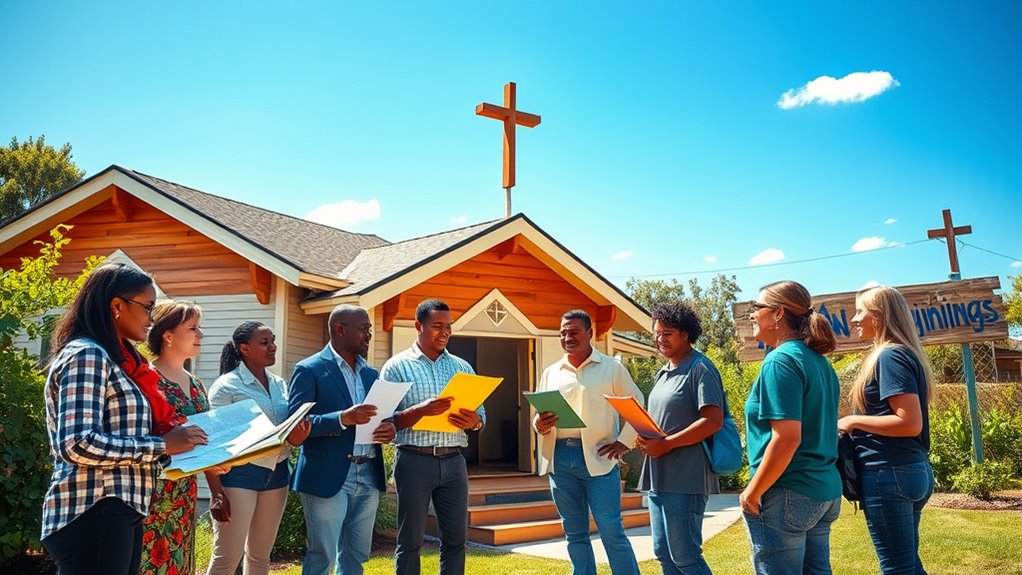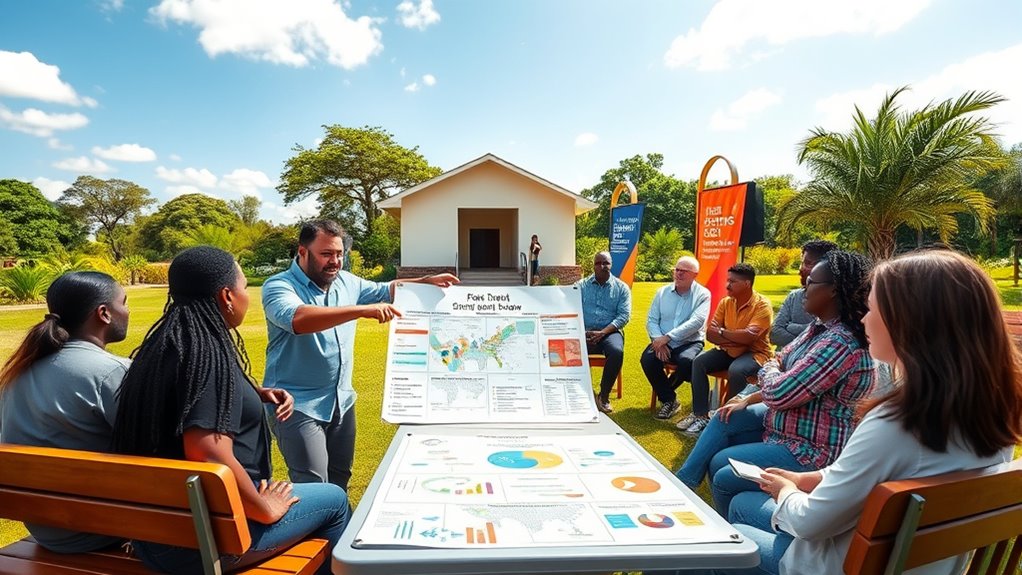To start a new church community, you need a clear vision and mission that reflect your purpose and connect with the community’s needs. Develop a strategic plan, set goals, and build a strong leadership team to stay focused. Engage locally through outreach and partnerships to build trust. Regularly evaluate progress and adapt to societal changes for sustainable growth. Keep exploring how to effectively launch and grow your church for lasting impact.
Key Takeaways
- Clearly define your church’s vision, mission, and community relevance to guide planning and outreach efforts.
- Develop a strategic plan with specific goals, budgets, and resources aligned with community needs.
- Build a diverse leadership team through training and mentorship to foster a healthy church environment.
- Engage the community through partnerships, events, and social media to establish trust and authentic relationships.
- Regularly evaluate worship, outreach, and growth strategies to stay adaptable and aligned with societal trends.
Clarifying Your Vision and Mission

To successfully plant a new church, you need a clear understanding of your vision and mission. This foundation guarantees your team stays aligned through vision alignment, keeping everyone focused on the church’s purpose. Clarify what you want your church to accomplish and who you want to reach. Mission clarity helps you communicate your goals effectively, guiding decision-making and outreach efforts. When your vision and mission are clear, it becomes easier to inspire others and build momentum. Take time to prayerfully define your core purpose and long-term objectives. This clarity provides a unified direction, enabling your team to work cohesively toward a shared goal. Without it, efforts can become scattered, diluting your church’s impact from the start. Incorporating the role of symbolism and aesthetics in your planning can also help foster a welcoming environment that reflects your mission. Paying attention to design elements such as decor and layout can reinforce your church’s identity and values, making a lasting impression on visitors. Additionally, understanding how community engagement influences growth and sustainability can help you build meaningful relationships that support your mission. Recognizing the importance of vetted equipment options ensures your church’s infrastructure supports your mission effectively, providing reliable systems for your community. Furthermore, understanding the role of visual clarity and image quality can enhance your outreach materials and presentations, making your message more compelling.
Developing a Strategic Plan and Budget

Creating a strategic plan and budget is essential for turning your church vision into action. Start by outlining clear goals, priorities, and timelines, guaranteeing your plan aligns with your mission. Focus on developing effective fundraising strategies to secure the necessary resources, including community outreach, grants, and donations. Incorporate fundraising techniques that resonate with your community to foster long-term support. Understanding the importance of technological innovations can also help streamline your fundraising and administrative processes, making your efforts more efficient. Additionally, engaging with visionary quotes can inspire your team and community to stay motivated and committed to your mission. Simultaneously, prioritize volunteer recruitment to build a strong, committed team that can support your initiatives. Assign specific roles and responsibilities, and create a system for ongoing volunteer engagement. Tracking your progress regularly, adjusting your plan and budget as needed to stay on course, is vital for success. A well-crafted strategy ensures that every dollar and volunteer hour is used efficiently, helping your church community grow sustainably and faithfully. Recognizing the state-specific benefits available can provide additional support and resources for your planning efforts. Incorporating effective fundraising strategies can significantly enhance your resource mobilization efforts.
Building a Core Leadership Team

Building a strong core leadership team is essential for launching and sustaining your church plant. Focus on leadership development by identifying individuals with passion, skills, and a heart for service. Invest in their growth through training and mentorship, creating a unified vision. Volunteer recruitment plays a pivotal role; look for committed people willing to serve and lead by example. Clearly define roles and responsibilities to foster accountability and clarity. As you build this team, prioritize diversity, ensuring different perspectives contribute to the church’s health. Regular communication and team meetings keep everyone aligned and motivated. Remember, a well-developed leadership team not only guides your church’s initial launch but also provides stability and momentum for long-term growth. Incorporating best practices in leadership can significantly enhance your team’s effectiveness and cohesion. Additionally, fostering a culture of accountability helps maintain focus and high standards within your team. Utilizing effective communication strategies can further strengthen team unity and clarity. Emphasizing resilience within your team encourages perseverance through challenges and setbacks, which is vital for sustained growth. Recognizing that ongoing leadership development ensures your team remains adaptable and prepared for future opportunities is also crucial.
Engaging the Community and Outreach Strategies

Engaging the community is essential for the success of your church plant, as it helps establish meaningful connections and trust. Strong community engagement opens doors for outreach strategies that resonate locally. To deepen your impact, consider these approaches:
- Partner with local organizations to serve community needs.
- Host events that invite participation and showcase your church’s heart.
- Use social media to share stories and promote outreach efforts.
- Volunteer regularly in community projects to build authentic relationships.
These outreach strategies not only increase visibility but also demonstrate your church’s genuine commitment. By actively engaging with your community, you foster trust and create a welcoming environment where new members feel connected and valued. Keep your outreach efforts intentional and rooted in love.
Launching and Sustaining Your New Church

Once you’ve established strong connections within your community, the next step is to launch your new church with clear purpose and strategic planning. Focus on worship planning to create meaningful, engaging services that resonate with your congregation and reflect your church’s mission. Consistent and inspiring worship helps build a sense of identity and unity. Additionally, incorporating sustainable building materials into your church infrastructure can demonstrate your commitment to ethical and environmentally responsible practices. Simultaneously, prioritize volunteer recruitment to ensure you have passionate, committed team members to support your activities. Effective volunteer recruitment involves clearly communicating roles, empowering leaders, and fostering ownership among volunteers. As you launch, maintain momentum by regularly evaluating your worship services and volunteer engagement. Staying adaptable and focused on your purpose will help your church not only launch successfully but also sustain growth and spiritual energy over time. Incorporating ethical considerations into your planning can also foster trust and integrity within your community. Additionally, understanding church growth strategies can provide valuable insights for ongoing development and outreach efforts. Paying attention to community needs can inform your outreach and service initiatives, ensuring your church remains relevant and impactful. Recognizing the importance of market trends in church planting can also help you align your efforts with broader societal shifts and interests.
Frequently Asked Questions
How Do I Secure Initial Funding for My Church Plant?
To secure initial funding for your church plant, start by exploring various fundraising strategies like hosting community events, online campaigns, and reaching out to local businesses. Additionally, research grant opportunities from religious organizations, community foundations, and faith-based grants. You should also build relationships with potential donors, share your vision passionately, and demonstrate how their support can impact your church’s growth and outreach efforts.
What Legal Steps Are Required to Establish a New Church?
You might find it surprising, but establishing a new church requires several legal steps. First, guarantee you meet legal compliance by registering your church as a nonprofit corporation in your state. Then, apply for federal tax-exempt status under 501(c)(3). Keep detailed records and obtain necessary licenses or permits. These steps help protect your church legally and financially, paving the way for a successful start.
How Can I Effectively Attract Diverse Age Groups?
To effectively attract diverse age groups, prioritize multigenerational engagement through activities that appeal to all ages. Use age-specific outreach strategies, like youth groups, senior ministries, or family events, to connect with each demographic. You should also foster an inclusive environment where everyone feels welcomed and valued. By intentionally designing programs for different age groups, you create a vibrant community that encourages participation across generations.
What Are Common Challenges Faced During the First Year?
Think of your first year as planting a garden—you’ll face weeds and storms. Common challenges include building strong community engagement and developing leadership. You might struggle to attract newcomers, keep volunteers motivated, or establish a clear vision. Staying flexible and investing in leadership development helps you adapt. Keep communication open and nurture relationships; these efforts will help your church thrive amid early hurdles.
How Do I Measure the Success of My Church Plant?
You measure your church plant’s success by tracking community engagement and spiritual growth. Notice how many new visitors attend and how actively they participate in events and small groups. Observe if members are growing in faith and sharing their faith with others. Regularly gather feedback to see if your community feels connected and supported. When these indicators improve, you’re on the right path toward a thriving, impactful church community.
Conclusion
As you plant your church, remember you’re nurturing a vibrant garden that will bloom with faith and community. Stay rooted in your vision, water it with passion, and watch as new life sprouts through outreach and leadership. With each step, you’re weaving a tapestry of hope that can transform lives. Keep your hands steady and your heart open—your church’s story is just beginning, and it’s destined to grow into something truly beautiful.










